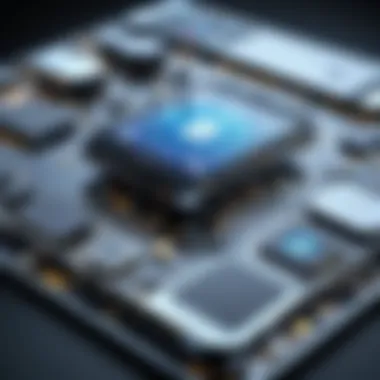Exploring Non-Traceable Phones and Their Impact on Privacy


Intro
As the thrumming engine of technology continues to evolve, personal privacy stands at a precarious juncture. With every click, swipe, or message sent, individuals unwittingly share pieces of their lives. Non-traceable phones have emerged as a beacon for those searching for sanctuary amidst this digital onslaught. They promise a realm where conversations are private, and movements remain unmonitored. The allure is palpable; yet, the implications stretch well beyond mere convenience. This article delves into the mechanics of these devices, their various applications, and the ethics entwined with their use.
The narrative of non-traceable phones isn’t just about their technical wizardry; it's about a cultural shift towards valuing personal privacy, often overshadowed by technological advancements that seem to prioritize connectivity over security.
In this exploration, we will traverse the landscape of non-traceable phones, unearthing significant aspects and essential knowledge that can arm the tech-savvy individual in navigating their digital existence more safely and thoughtfully.
Prelude to Non-Traceable Phones
In our fast-paced digital world, the conversation around non-traceable phones has gained momentum, positioning it as a crucial topic. These devices are not just gadgets; they symbolize a growing desire for privacy amidst a backdrop of increasing surveillance and data collection. The importance of this section lies in contextualizing the broader implications and benefits associated with non-traceable phones.
Defining Non-Traceable Phones
When we talk about non-traceable phones, we’re discussing devices designed to operate without leaving a digital footprint. Unlike standard smartphones that connect to networks and can be tracked easily, non-traceable phones utilize various methods to mask the user’s identity and location. This could mean using specialized networks or technologies that prioritize encryption and anonymity, ensuring that communication remains confidential.
Some examples of non-traceable phones include burner phones, which are often used temporarily, and privacy-focused smartphones that come preloaded with software to protect user data. The core idea is clear: these devices aim to give users control over their communication without the anxiety of being monitored.
The Need for Privacy in Modern Communication
In the age of information, the need for privacy in communication cannot be overstated. With corporations and governments ready to collect and analyze data, many individuals fear that their dialogues and activities are under constant scrutiny. Privacy has transitioned from a preference to a fundamental need, as people seek refuge from pervasive surveillance.
A variety of factors contribute to this growing demand for privacy. High-profile data breaches and revelations about mass surveillance have left many questioning who really has access to their personal information. In addition, as cyber threats become more sophisticated, the risk of having sensitive data compromised continues to rise.
Understanding the desire for non-traceable phones is essential because they represent a means to reclaim that lost privacy. They enable a safe space for communication, allowing individuals to connect without the worry of being watched or monitored by unseen eyes.
"In a world where everything is connected, the need for non-traceable communication is not just a luxury; it's a necessity."
In summary, this section touches on defining non-traceable phones and articulating the pressing need for privacy in our interconnected lives. As more people recognize the vulnerabilities in conventional communication methods, non-traceable phones emerge as a viable solution. This conversation sets the framework for the following sections where technology, types, and the various implications of these devices will be explored.
Technology Behind Non-Traceable Phones
The increasing reliance on digital gadgets has led to a surge in demand for privacy-enhancing technologies. Non-traceable phones stand as a cornerstone in this domain, primarily by prioritizing individual privacy and security. By delving into the technical underpinnings of these devices, one can glean an understanding of how they function and what sets them apart from typical smartphones. Exploring the technology behind non-traceable phones is essential because it informs users about the practices that can protect their communication from prying eyes and enables them to make educated choices regarding their privacy needs in a data-saturated world.
Non-traceable phones use a blend of intricate protocols, strong encryption, and specialized hardware, all serving to shield user data. It is important to highlight these elements as each plays a pivotal role in safeguarding information while still maintaining functionality.
Anonymity Protocols Explained
Anonymity protocols form the bedrock of non-traceable phones. They ensure that communications remain private and undisclosed, often using a mix of techniques like onion routing and peer-to-peer networks.
One popular protocol employed is Tor, which obscures a user’s IP address by routing internet traffic through various nodes around the world. This makes it exceedingly difficult for anyone to pinpoint the user’s exact location or identify their online activities. Another method involves decentralized networks that do not rely on a single point of failure, thus maintaining a higher level of privacy.
These anonymity protocols work hand-in-hand with various applications tailored for secure communication, helping users navigate the web without leaving a trace.
Encryption Techniques Used
The backbone of privacy in non-traceable phones lies in the encryption techniques utilized. End-to-end encryption is one of the most significant methods, ensuring that messages are locked away until they reach their intended receiver. This means that not even the service provider can access the content.
Some common encryption standards include the Advanced Encryption Standard (AES), which is known for its robustness and speed. Meanwhile, asymmetric encryption employs a public key to encrypt the data, and only the corresponding private key can decrypt it. This layered approach secures communications from snoopers, obstructing access regardless of the communication medium.
Moreover, certain devices take a step further by using forward secrecy, which generates new encryption keys for each session, thus rendering any intercepted data useless later on.
Hardware Specifications of Non-Traceable Devices
When it comes to hardware, non-traceable devices are designed with privacy in mind. Typically, they will incorporate specialized components that enhance security capabilities.


- Secure Enclaves: Many models feature secure enclaves, isolated areas within the phone’s processor dedicated to storing sensitive information safely.
- Custom Firmware: Non-traceable phones often run on custom firmware, devoid of unnecessary applications that could compromise user data.
- Enhanced Chipsets: These devices use chipsets developed specifically to support anonymity and encryption tasks, which also increases performance during data protection processes.
- Physical Security Features: Some models integrate additional security by including removable SIM cards and options for hardware-level resets to wipe data instantly.
By virtue of these innovations, non-traceable phones carve a niche in the technology landscape, promising users a semblance of privacy that ordinary devices fail to provide.
"As technology continues to evolve, so do the protective measures surrounding our private information. Knowledge of these protocols and hardware specifications is not just useful, but essential."
Overall, the technology behind non-traceable phones encompasses various intriguing elements all aimed at preserving user anonymity and fortifying communication security. Each technical detail is designed to arm users against the encroaching tide of surveillance, ensuring that personal conversations remain just that—personal.
Types of Non-Traceable Phones
The discussion around non-traceable phones is crucial in the context of increasing concerns about privacy. With the digital age marching forward, individuals find themselves tangled in a web of surveillance and data collection that can feel suffocating. Understanding the different types of non-traceable phones provides insight not only into how individuals can safeguard their privacy but also highlights the varying options available based on specific needs and situations.
Different types of non-traceable phones cater to different user requirements, whether it be fleeting communication or long-term anonymity. Below are the established types, each presenting its unique features and advantages:
Burner Phones
Burner phones are often seen as the poster child for non-traceable communication. These devices are typically prepaid and can be disposed of once used, making them an appealing option for people wanting to keep their identity under wraps.
Key Attributes:
- Temporary Nature: Users can buy a burner phone, use it for a short while, and then dispose of it without leaving behind a digital footprint.
- Low Cost: These phones are often affordable, eliminating financial barriers for those seeking privacy.
- Accessibility: They can be found in convenience stores or online, making them easy to obtain quickly in emergencies.
"Burner phones can be a lifesaver when you need to talk without being monitored. They provide a way to stay off the grid, if only for a little while."
Privacy-Focused Smartphones
Not all non-traceable devices are as rudimentary as burner phones. Privacy-focused smartphones offer a blend of functionality and security. These devices may come equipped with specific operating systems and features designed to enhance user privacy.
Important Features:
- Enhanced Security Features: Many come preloaded with tools that regularly encrypt data and communications. For instance, some might have apps designed to block tracking by advertisers.
- Open-Source Options: Several smartphones operate on open-source systems, allowing the user to customize and secure their device against potential threats.
- User Education: As they market themselves around privacy, these phones often come with guides and tips to further secure the user's information.
Secure Communication Devices
These devices go the extra mile, focusing primarily on secure communication rather than general functionality. Secure communication devices are built with specialized hardware and software that helps to ensure that messages and voice calls remain confidential.
Noteworthy Characteristics:
- Advanced Encryption: They often utilize high-grade encryption protocols to ensure that any form of communication is nearly impossible to intercept.
- Limited Functionality: Unlike traditional smartphones, these devices may forgo some modern features to concentrate on security. The goal is to create a safe communication channel rather than a multi-functional gadget.
- Professional Use: Many in the corporate or government sectors rely on these devices for sensitive discussions, recognizing that casual smartphones are not foolproof.
This exploration of non-traceable phones serves as a guide for tech-savvy individuals, leading them toward informed choices in an era where digital privacy has become a growing concern.
Use Cases of Non-Traceable Phones
Non-traceable phones serve vital purposes in today's fast-paced, privacy-sensitive environment. As technology evolves, the need for secure and anonymous communication becomes ever more pressing. Individuals and businesses alike are recognizing the benefits these devices offer in various scenarios. Here, we’ll unpack how non-traceable phones can be invaluable tools in preserving privacy and enhancing safety across personal, professional, and travel contexts.
Personal Privacy: Avoiding Surveillance
In a world that increasingly scrutinizes every digital footprint, personal privacy has taken center stage. Many individuals are growing weary of being monitored by corporations and governments alike. Non-traceable phones provide a refuge in this atmosphere of pervasive surveillance.
- Protection of Personal Information: When using these devices, users can avoid the relentless data mining by big tech companies. For instance, a non-traceable phone can help keep personal conversations out of prying eyes.
- Preventing Unwanted Tracking: Many people have experienced that uncomfortable feeling of being tracked. Non-traceable phones enable users to communicate freely without fear of location tracking or data profiling.
"Privacy isn’t a luxury; it’s a necessity, especially in our digital age."


Business Communications: Protecting Sensitive Information
The stakes are high in the corporate world. Sensitive information leaks can lead to significant financial losses or reputational damage. Non-traceable phones are pivotal in securing business communications.
- Confidential Discussions: Employees can hold discussions concerning trade secrets or sensitive negotiations without the fear of eavesdropping. This assurance can foster a more open environment for brainstorming ideas and discussing strategies.
- Mitigating Cyber Threats: Cybersecurity threats loom large over businesses today. A non-traceable phone can serve as an additional layer of protection against cyber threats, allowing secure exchanges of information that might otherwise be exposed through insecure channels.
Travel Safety: Minimizing Risk
Traveling opens up a multitude of risks, particularly in regions where political unrest or crime rates are high. Non-traceable phones can significantly enhance travel safety by minimizing various risks.
- Avoiding Theft of Personal Information: Upon traveling to foreign countries, tourists often become targets for thieves looking to access personal information. Non-traceable phones can operate as a safeguard, allowing travelers to keep their information secure while staying connected.
- Emergency Communication: In desperate situations, having a reliable communication channel is crucial. A non-traceable phone ensures that travelers have a way to reach local authorities or emergency services without leaving a data trail that could be exploited.
Legal and Ethical Considerations
The intersection of technology and privacy raises various legal and ethical questions. As non-traceable phones gain traction, it becomes vital to recognize how these devices challenge existing laws and societal norms. This section delves into regulations concerning privacy technology, the delicate balance between security and privacy, and the ethical dilemmas emerging from non-traceable communications. By exploring these dimensions, readers can better understand both the implications and the responsibilities that come with using such devices.
Regulations on Privacy Technology
Legal frameworks surrounding non-traceable phones are often convoluted. Different countries have distinct regulations that govern the use of privacy technologies. For instance, in many jurisdictions, there are strict laws about data protection and how personal information is stored or transmitted. The General Data Protection Regulation (GDPR) in Europe is one significant example, placing emphasis on consent, data minimization, and the rights of individuals regarding their data.
In contrast, the USA lacks a comprehensive federal law; instead, privacy is managed through a mix of state laws and sector-specific regulations. This creates a patchwork of legal standards, which can make compliance tricky for companies managing non-traceable phone technologies.
"Privacy is not an option, and it shouldn't be the price we accept for just getting on the internet."
—Gary Kovacs
Regulatory bodies are continuously adapting to technological advancements, striving to offer consumer protection while encouraging innovation. Therefore, those using non-traceable phones must stay informed about the laws in their location.
The Balance Between Security and Privacy
Finding harmony between security and privacy is a nuanced endeavor. On one hand, there’s the necessity for law enforcement to have tools to prevent crime and enforce laws; on the other hand, individuals have the right to safeguard their personal information. Non-traceable phones often spark concern within governmental agencies regarding their use in illicit activities, posing serious questions about how to regulate technology without infringing on personal freedoms.
Striking a balance could include targeted surveillance with sufficient legal oversight, ensuring that security measures don’t overreach into private lives.
One pertinent example is the debate surrounding end-to-end encryption, a feature found in many non-traceable devices. While encryption protects user privacy, it can also hinder investigations into criminal organizations. Striking this balance is crucial for a society aiming to respect individual freedom while maintaining security.
Ethical Dilemmas in Non-Traceable Communication
The ethical implications surrounding the use of non-traceable phones are multi-pronged. Users must ask themselves about the intentions behind their privacy needs. Are they shielding themselves from unwarranted scrutiny, or do they intend to hide illicit activities? The context matters immensely, as ethical responsibilities shape how technology is used.
Moreover, manufacturers of non-traceable devices often find themselves in morally ambiguous situations. While they design technology to protect user privacy, their products could potentially empower malicious actors. Ensuring robust mechanisms to prevent misuse while promoting privacy becomes a complex task that demands constant vigilance.
Ultimately, understanding these ethical dilemmas equips users and developers with the insight to navigate the potential pitfalls inherent in adopting non-traceable technology. In a world where digital footprints are ever-present, remaining conscious of both the rights and responsibilities that accompany privacy choices is essential.
Security Risks Associated with Non-Traceable Phones
Understanding the security risks tied to non-traceable phones gives clarity in a world where privacy is often compromised. As people prioritize their personal information's security, these devices offer a tempting solution, albeit not without dangers. Ignoring these risks could lead to unforeseen consequences, making it essential to evaluate how non-traceable phones can play both defense and offense in the digital privacy arena.
Vulnerabilities in Technology
Non-traceable phones operate on advanced technologies designed to enhance privacy. But with innovation always comes vulnerability. Cybersecurity threats loom large here. For instance, many non-traceable phones rely on outdated software. This can present an easy target for hackers seeking a way into private data. The idea is alluring: owning a device that safeguards your identity. Yet, beneath the glossy surface lie potential pitfalls.
One key weakness lies in the reliance on Wi-Fi networks. Many non-traceable devices are designed to operate off local networks to avoid larger networks that could trace a user's activity. This creates a double-edged sword. Accessing public Wi-Fi can expose users to malicious actors, lurking and ready to pounce.
Moreover, some non-traceable systems utilize peer-to-peer networks. This can also lead to exposure, potentially enabling third parties to glimpse sensitive information. Users must understand that having a non-traceable phone doesn’t equate to absolute safety. Maintaining up-to-date software, utilizing strong passwords, and ensuring network security practices are vital steps in navigating these vulnerabilities.


Security is a continuous dance; remaining ignorant is a lag behind the music.
Potential for Misuse in Criminal Activity
While many individuals purchase non-traceable phones with good intentions—like personal privacy or protection from surveillance—there's a darker side. These devices can be exploited by those with nefarious motives. For instance, the anonymity provided can shield criminal activities. In the wrong hands, a non-traceable device becomes a tool for unlawful endeavors, from illicit trade to organized crime.
Law enforcement finds itself in a tight corner, challenged by the layers of anonymity. The onion routing systems, for example, offer users hidden pathways, creating additional barriers for tracing illegal operations. Furthermore, authorities encounter setbacks when distinguishing between innocent users and those engaging in criminal activities. This complexity raises a crucial question: Should the benefits of privacy compromise safety?
In summary, while the allure of non-traceable phones is understandable, the associated risks cannot be overlooked. The balance between personal privacy and societal safety remains a fraught landscape. For the tech-savvy, it’s essential to tread carefully, staying informed about both the advances in privacy technology and the potential for misuse. Only then can one fully realize the implications of owning such a device without falling into the traps they may present.
Future Trends in Non-Traceable Technology
In our increasingly digital society, the advent of non-traceable phones marks a significant juncture in the realm of personal privacy. As technology evolves, so does the landscape of privacy and the quest for anonymity. Understanding future trends in non-traceable technology is essential for grasping not only how privacy is being reshaped but also for anticipating how individuals might safeguard their digital footprints. The intersection of innovation and privacy is a crucial focus area, as it promises to empower users with greater control over their personal information.
Emerging Technologies Enhancing Privacy
New advancements in technology continually push boundaries, and this has direct implications for the privacy of smartphone users. The emergence of decentralized apps, often called dApps, significantly contributes to maintaining user secrecy. These applications operate on a peer-to-peer network and don’t depend on a central server, thus reducing the risk of data exposure.
Furthermore, developments in biometric security technologies are gaining ground. Devices that utilize facial recognition or fingerprint scanning create a unique user identification that's much harder to replicate. This method is not only convenient but also adds a layer of security that traditional passwords cannot match. The integration of blockchain technology further enhances privacy. In simple terms, blockchain offers a way to record transactions securely and transparently without the need for intermediaries.
- Key technologies shaping the future of privacy include:
- Decentralized applications (dApps)
- Biometric security measures
- Blockchain integration
These emerging technologies offer robust solutions for non-traceable communication. Their development will likely continue, leading to even more innovative approaches for protecting users’ identities in the digital sphere.
The Evolving Landscape of Consumer Demand for Privacy
The consumer attitude towards privacy is undergoing a fundamental shift. People are becoming increasingly aware of the implications of data breaches and surveillance, which spurs a growing desire for privacy-centric solutions. As media stories about data mishandlings surface, individuals are no longer willing to accept the trade-off between convenience and privacy.
This shift in mindset is poised to impact market trends significantly. More manufacturers are investing in privacy features in their devices. Consumers are on the lookout for phones that guarantee stronger encryption and less data collection, steering clear from brands that fail to prioritize user privacy.
"Privacy is not an option, and it shouldn’t be the price we accept for just getting on the Internet.”
As the conversation around privacy expands, it's likely that we will see more personalized privacy controls tailored to individual needs. This might include advanced settings to help users decide what data they wish to share and with whom.
- Potential consumer demands in the future:
- Greater control over personal data
- Transparency in data usage by manufacturers
- Innovative privacy features that blend seamlessly into typical usage
Culmination
In the broader discourse surrounding privacy in our digital age, understanding non-traceable phones stands as a pivotal element. These devices, while being characterized by their anonymity features, touch upon various nuances that argue for their relevance not just in personal use but also in wider societal conversations.
Summarizing Key Points
To encapsulate the dialogues fostered in this article:
- Definition & Technology: Non-traceable phones are defined primarily by their ability to safeguard user identity, enabled through advanced technology like encryption and hardware-specific features.
- Legal and Ethical Matters: These phones tread a fine line between legitimate use for privacy and potential misuse for illicit activities. Hence, the legal implications remain murky, shedding light on why such devices create heated debates.
- User Trends: There is an observable surge in demand for privacy, especially among tech-savvy individuals who grasp the importance of protecting personal data in an age marked by surveillance and data breaches.
In summary, while these gadgets promise a certain level of security against prying eyes, their implications are multi-faceted, influencing both individuals and legal bodies.
The Importance of Understanding Privacy Technology
The topic of privacy technology can't be overstated; understanding it relates directly to individual safety and autonomy in a world inundated by invasive data collection practices. As the mechanisms behind non-traceable phones evolve, so too must our grasp of these innovations.
- Awareness: Individuals equipped with knowledge about non-traceable technology are better positioned in safeguarding their privacy.
- Informed Choices: With knowledge comes empowerment. Users can select devices that align with their values and needs.
- Responsibility: This understanding brings to mind the ethical obligations associated with the responsible use of technology, urging users to consider the implications of their choices not only on themselves but also on society at large.
Understanding non-traceable phones thus becomes not just a technical appreciation but a deeper recognition of how it intersects with our rights, privacy, and the evolving landscape of communication.



